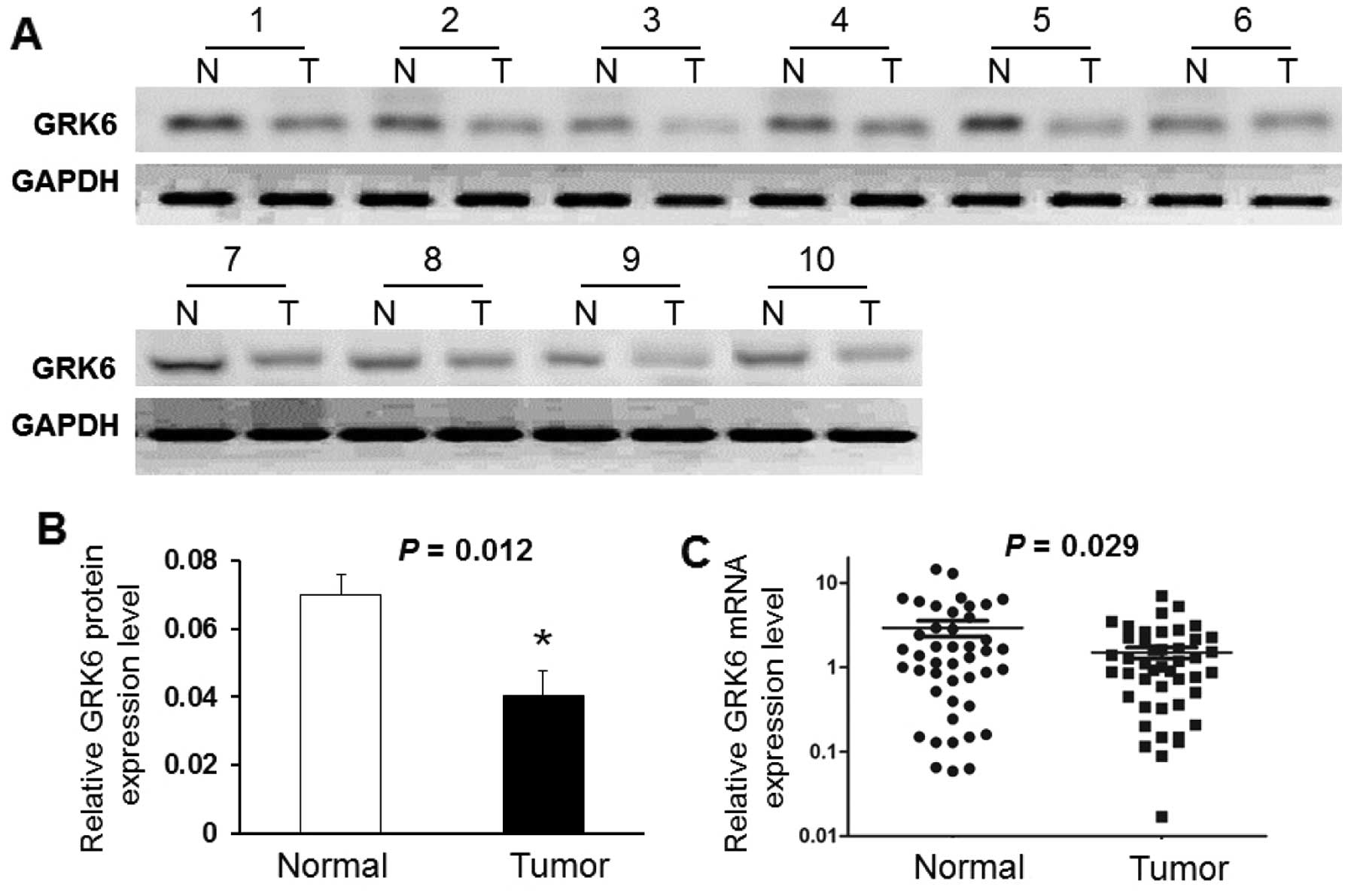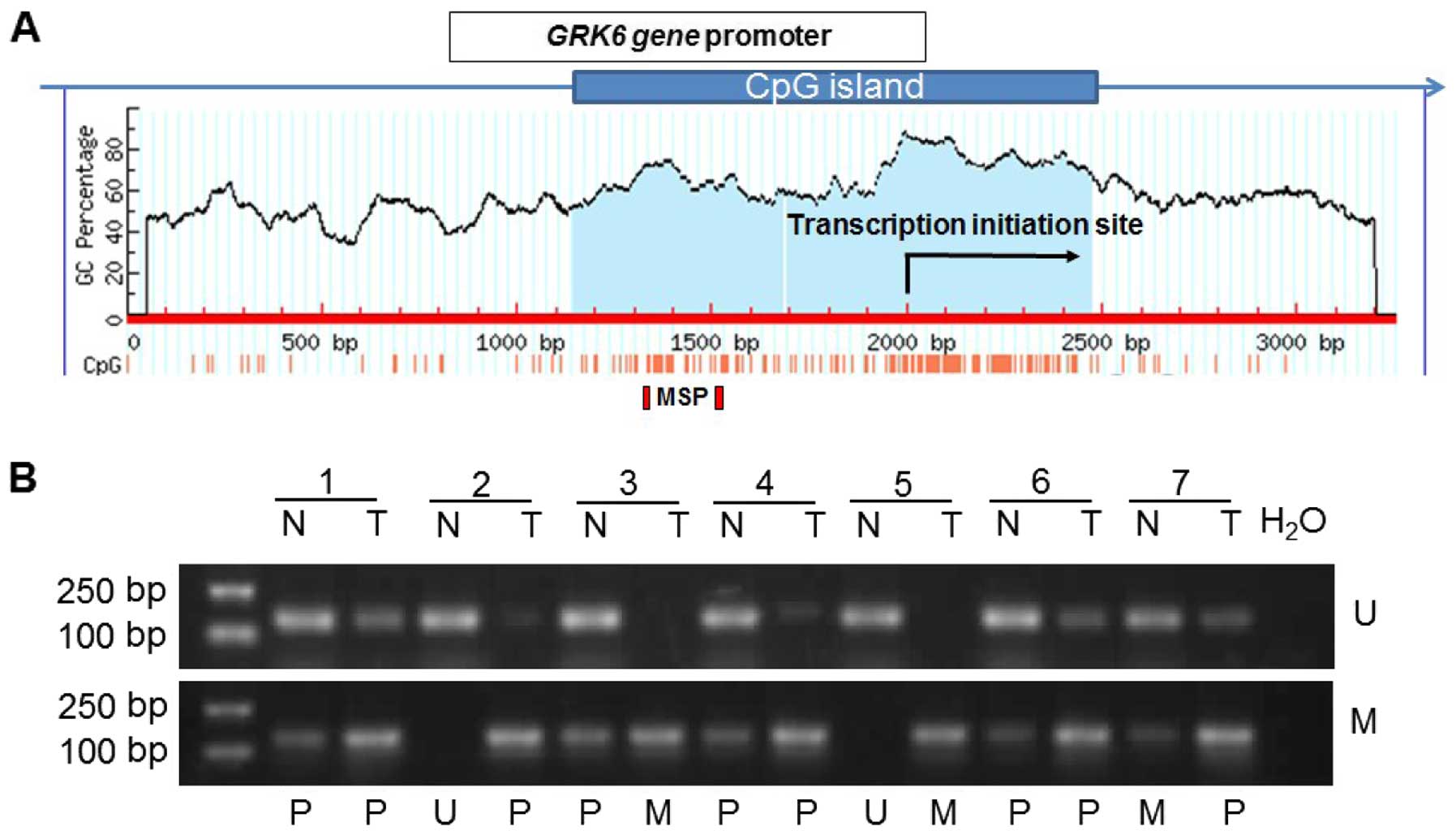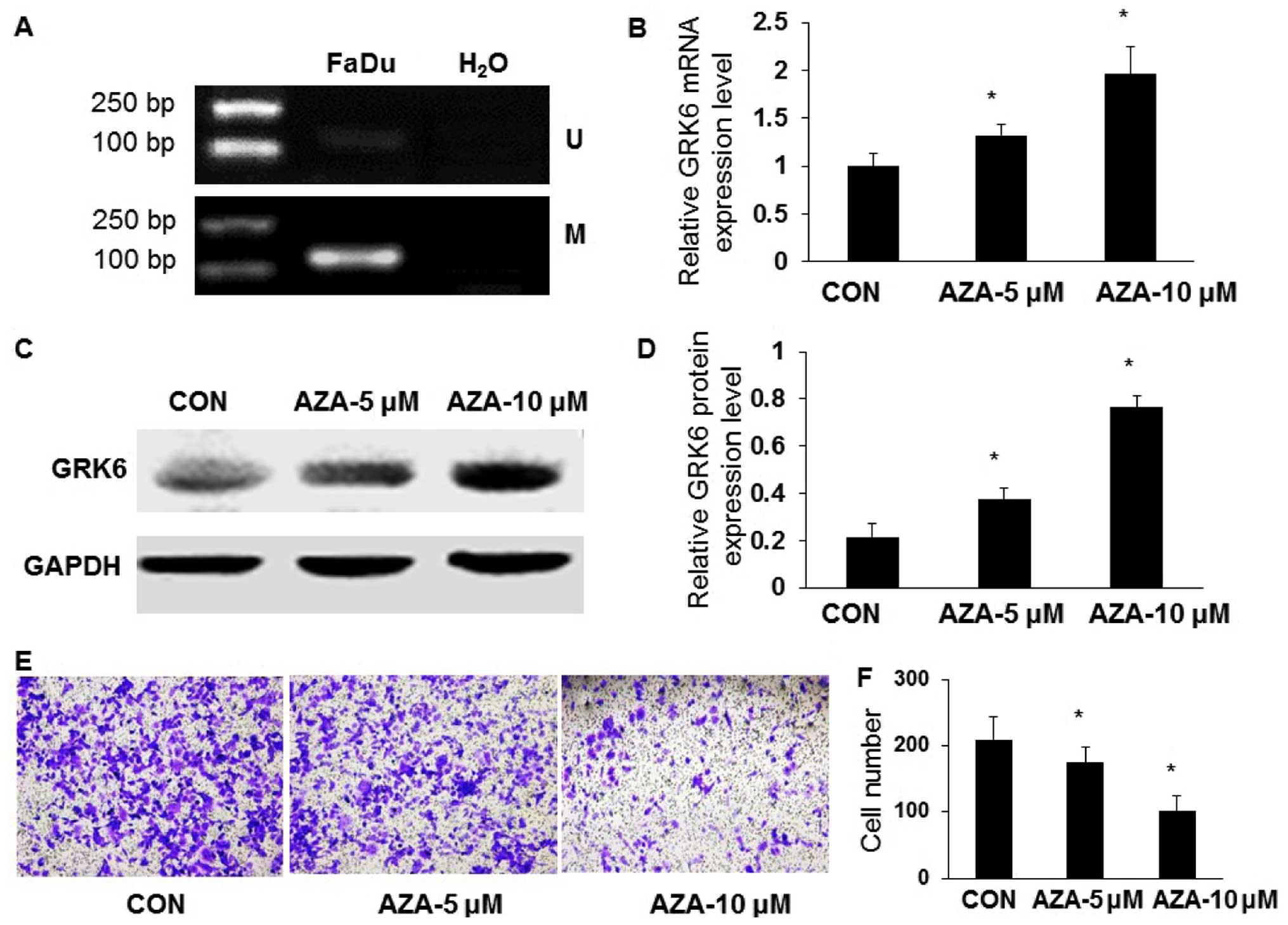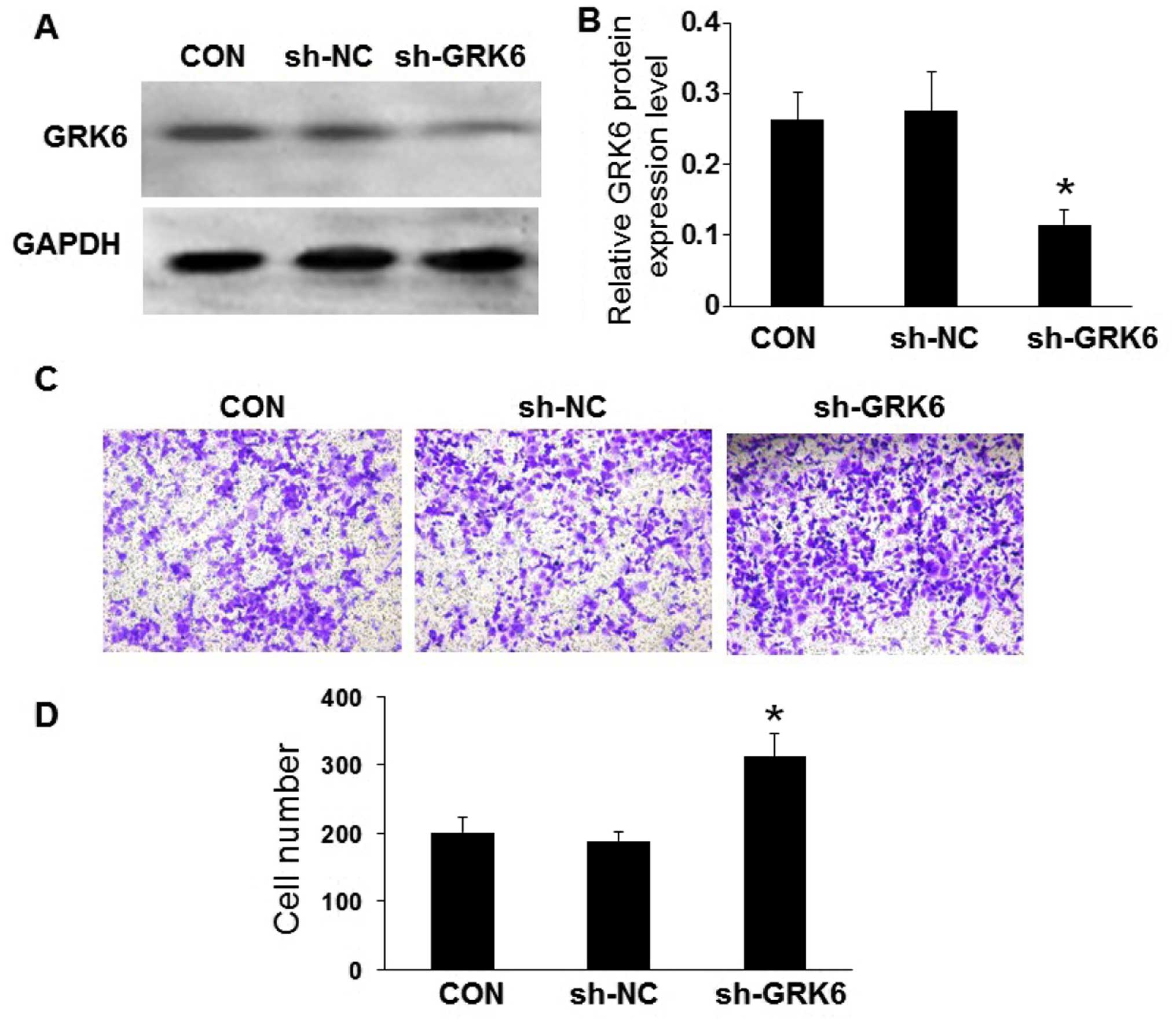Introduction
Hypopharyngeal squamous cell carcinoma (HSCC), a
malignant neoplasm arising from the outer layer (epithelium) of the
hypopharynx, is a subset of head and neck cancer with particularly
poor prognosis and more aggressive behavior (1). Over the last decades, although
diagnosis and treatment methods including surgical resection,
radiation therapy, and neoadjuvant chemotherapy for HSCC are
continuously improving, the 5-year survival rate of patients with
HSCC is only ~25–40% (2).
Understanding the molecular pathophysiology of HSCC is essential
for determining how to effectively inhibit tumor progression and
metastasis. Therefore, to identify targeted therapeutics against
progression and metastasis, a better understanding cellular and
molecular mechanism of the regulation of HSCC cell invasion is
needed.
G protein-coupled receptor kinases (GRKs) are a
family of serine/threonine protein kinase that phosphorylate
Ser/Thr residues in the cytoplasmic domains and tails of activated
G protein-coupled receptors (GPCRs). Receptor phosphorylation
triggers a cascade of events that includes the recruitment of
arrestins to bind to the phosphorylated Ser/Thr residues of GPCRs,
receptor internalization and precluding G protein coupling, thereby
preventing reactivation of the signaling pathway (3,4).
Although GRKs have a crucial function in desensitization,
maladaptive GRK activity has been implicated in a range of human
diseases, including heart failure, opiate addiction and tumor
progression and metastasis (3,5,6).
Therefore, GRKs are considered important therapeutic targets
(4–6). GRK6 is expressed in many human
tissues, and participates in the pathological process of many
diseases (7–10). Recently, some studies reported GRK6
also has been implicated in various cancer metastasis, including
lung cancer (11), medulloblastoma
(12) and multiple myeloma
(10). However, the specific roles
and regulation of GRK6 in HSCC have not been investigated.
In the present study, we investigated GRK6
expression in HSCC and also assessed the possible cause of its
aberrant expression. In addition, we assessed the GRK6 gene
promoter methylation status in HSCC cell lines and HSCC tissues,
and evaluated its clinical significances. The role of GRK6 might
provide new insights into the tumorigenesis of HSCC.
Materials and methods
Human tissue specimens
A total of 45 pairs of primary hypopharyngeal
squamous cell carcinoma (HSCC) and corresponding non-malignant
tissue specimens were obtained from patients with HSCC at the
Affiliated Hospital of Nantong University and General Hospital of
Jinan Military Region between July 2003 and June 2011. Clinical
characteristics of HSCC patients were extracted from their medical
records, including: gender, age, histological type, differentiation
grade and tumor stage. None of the cancer patients received any
type of treatment (radiation therapy, chemotherapy or
immunotherapy) before surgery. Specimens were collected immediately
after tumor excision during surgery. All specimens were subjected
to histological diagnosis by a pathologist. The study protocol was
approved by the Human Research Ethics Committee of the Affiliated
Hospital of Nantong University and General Hospital of Jinan
Military Region, and all patients provided written informed consent
prior to participation in the study.
Cell culture
The human HSCC cell line, FaDu cells, was purchased
from the American Type Culture Collection (ATCC; Manassas, VA,
USA). FaDu cells were cultured in Dulbecco's modified Eagle's
medium (DMEM; Invitrogen, Carlsbad, CA, USA) supplemented with 10%
fetal bovine serum (FBS; Invitrogen) at 37°C in a humidified
incubator with 5% CO2.
RNA extraction and real-time quantitative
PCR (qPCR)
Total RNA was extracted from FaDu cells, human HSCC
tissues, and corresponding non-malignant tissues from the same
patients. Extraction was done using with TRIzol reagent, as
described by the manufacturer (Invitrogen). One microgram of DNase
I-treated (Fermentas, Vilnius, Lithuania) total RNA were converted
to cDNA using a Reverse Transcription System kit (Fermentas,
Burlington, ON, Canada). The GRK6 mRNA expression level was
determined by following Maxima SYBR Green/ROX qPCR Master Mix kit
(Fermentas) with the following primer specific either for GRK6 or
the housekeeping gene GAPDH (internal control). GRK6:
5′-AAAACACCTTCAGGCAATACCG-3′ (sense) and
5′-AGGCCAAGCTCACTACAAACCTA-3′ (antisense); GADPH:
5′-CATGAGAAGTATGACAACAGCCT-3′ (sense) and
5′-AGTCCTTCCACGATACCAAAGT-3′ (antisense). As a negative control we
used DEPC-treated water to replace cDNA templates for every PCR.
The relative quantitative value was expressed by the
2−ΔΔCt method.
Protein isolation and western
blotting
Human HSCC tissues and their corresponding
non-malignant tissues were homogenized in RIPA lysis buffer, and
the lysates were cleared by centrifugation (12,000 rpm) at 4°C for
20 min, and denatured by boiling for 5 min. Equal amounts of
protein (30 µg) were electrophoresed in 10% polyacrylamide
gels. Subsequently, the proteins were transferred to PVDF membranes
(Millipore, Bedford, MA, USA). The membranes were blocked with 5%
non-fat dry milk in TBST buffer for 1 h at room temperature and
incubated with a rabbit polyclonal anti-human GRK6 antibody (1:300;
Santa Cruz Biotechnology, Inc., Santa Cruz, CA, USA) or an
anti-GAPDH (internal control) at 4°C overnight at room temperature.
The next day, the membranes were washed three times with TBST,
after which they were incubated for 2 h with a 1:2,000 dilution of
secondary antibodies. After washing, immunoreactive protein bands
were visualized using an electrochemiluminescence (ECL) detection
kit (Thermo Fisher Scientific Inc., Rockford, IL, USA). Protein
bands were scanned and quantified using a Gel Image Analysis
System. Each experiment was repeated three times. The protein
levels were normalized to that of GAPDH.
Genomic DNA isolation and MSP
Genomic DNA was extracted from FaDu cell line and
primary HSCC tissues through SDS/proteinase K treatment, followed
by phenol-chloroform extraction and ethanol precipitation.
Bisulfite treatment was performed using the EZ DNA Methylation-Gold
kit (Zymo Research, Irvine, CA, USA), according to the
manufacturer's instructions. http://www.urogene.org/cgi-bin/methprimer/methprimer.cgi
was used to analyze the 3000 bp region of the GRK6 gene promoter
region (−2000 bp to +1000 bp) for the presence of CpG islands.
After prediction analysis, we found two CpG islands (−855 to −318
and −310 to +475). The GRK6 methylation-specific primers used were
5′-TGGGTGGAGAGAAATTATAATATTC-3′ (sense) and
5′-TATAACCGTATTCCCTTAAATCGAC-3′ (antisense), 167 bp; and the
unmethylation-specific primers used were
5′-GGTGGAGAGAAATTATAATATTTGG-3′ (sense) and
5′-TATAACCATATTCCCTTAAATCAAC-3′ (antisense), 165 bp. The reaction
mixture contained 1 µl DNA in a volume of 50 µl
containing 1 µl of each primer, 2X GC buffer I, 2.5 mM dNTP
Mix and 2.5 U LA Taq (Takara). The MSP conditions were as follows:
94°C for 5 min, 40 cycles of 94°C for 30 sec, 54°C for 30 sec, 72°C
for 45 sec and 72°C for 10 min. Water was run as a negative control
in every MSP reaction. All procedures were repeated three times.
The PCR products were subjected to 2% agarose gel electrophoresis
at 100 V for 30 min.
Treatment of cells with 5-Aza-dC
HSCC cells (FaDu) were seeded at a density of
5×105 cells/well in 6-well culture plates in DMEM
(Invitrogen) containing 10% FBS, and incubated in a humidified
atmosphere of 5% CO2 at 37°C. After overnight culture,
cells were incubated with medium containing 0, 5 and 10
µmol/l 5-Aza-2′-deoxycytidine (5-Aza-dC) (Sigma, St. Louis,
MO, USA) for 3 days. Total RNA was isolated after treatment, and
mRNA was analyzed by qPCR as described above.
Lentivirus-mediated shRNA knockdown of
GRK6 expression
The target sequence of GRK6 siRNA sequence
(5′-GCCGACUACCUCGACAGCAUCUACU-3′) was used as previously described
(13), a scrambled sequence
(5′-TTCTCCGAACGTGTCACGT-3′) was used as negative control for RNA
interference (RNAi), which had no significant homology to any human
gene sequences. Inverted and self-complementary hairpin DNA oligos
targeting GRK6 mRNA were obtained from Genchem Biotechnology Co.
(Shanghai, China). The stem-loop oligonucleotides were synthesized
and cloned into a lentivirus-based vector pGCSIL-GFP and resulting
plasmids were named as GRK6-shRNA and scrambled shRNA respectively.
Lentiviral vector production was performed according to standard
Invitrogen protocol. Then the lentiviral titers of GRK6-shRNA and
scrambled shRNA were identified. Experiments for lentivector
transduction were carried out as follows: human HSCC cell line FaDu
were plated at 5×105 cells in 6-well culture plates, and
transducted with scrambled shRNA, GRK6-shRNA lentivirus at a
multiplicity of infection (MOI) of 20 in the presence of 8 mg/ml of
polybrene. After 24 h, the medium was replaced with fresh DMEM
containing 10% FBS and the cells were cultured for another 48 h.
Cells were harvested at 72 h after infection and the knockdown
efficiency of GRK6 was evaluated by quantitative real-time PCR and
western blot analysis.
Transwell chamber invasion assay
The human HSCC cell line, FaDu cells, incubated with
5-Aza-dC for 3 days or transfected with GRK6-shRNA lentivirus were
separately detached from the culture plates, then seeded onto
Matrigel-coated 8 µm pore size Transwell filters (Corning
Life Sciences, Corning, NY, USA) in the upper well at the density
of 5×104 per in 200 µl of culture medium (DMEM
containing 1% fetal calf serum), in the lower chamber, 500
µl DMEM containing 10% FBS was added as a chemoattractant.
After 24 h of incubation, non-invading cells on the upper wells
were removed with a cotton-tipped swab. Then, the lower side of the
filters were fixed in 4% paraformaldehyde for 10 min, and stained
with 0.1% crystal violet for 30 min. The invaded cells were viewed
under a microscope and counted in five fields of view at ×200
magnification. The invasion ability of the cancer cells was
expressed as the mean number of cells in five fields. The assay was
performed in three independent experiments.
Statistical analysis
Statistical analyses were performed using SPSS 18.0
software (SPSS, Inc., Chicago, IL, USA). We used the χ2
test for clinicopathological features, and the Student's t-test or
one-way ANOVA test for continuous variables. Data are expressed as
mean ± SD. P<0.05 was considered statistically significant.
Results
GRK6 expression is downregulated in HSCC
tissues
We investigated GRK6 protein and mRNA levels in the
hypopharyngeal squamous cell carcinoma (HSCC) specimens and
corresponding non-malignant tissues by western blotting and
quantitative real-time PCR. Western blot analysis showed that the
expression level of GRK6 protein was significantly decreased in 18
of 25 paired HSCC tissues compared with the corresponding adjacent
non-malignant tissues, and ten cases of the representative western
blotting results are shown in Fig.
1A. Moreover, the average GRK6 protein level in HSCC tissues
was significantly lower than that of GRK6 in adjacent non-malignant
tissues (P=0.012; Fig. 1B). In
addition, the results of quantitative RT-PCR revealed that GRK6
mRNA expression was downregulated in 32 of 45 paired HSCC samples
compared with corresponding non-malignant tissues. The mean
expression value of mRNA in HSCC tissues was sig nificantly lower
than the value in paired adjacent nonmalignant tissues (P=0.029;
Fig. 1C).
Low expression of GRK6 is related to DNA
methylation
To identify whether low GRK6 expression was due to
DNA methylation, MSP was used to examine DNA methylation status of
GRK6 gene promoter CpG islands in 45 paired HSCC specimens and
corresponding non-malignant tissues. DNA methylation occurred in
77.8% (35/45) of HSCC tissues and 42.2% (19/45) of non-malignant
tissues. No methylation was observed in 22.2% HSCC tissues and
57.8% non-malignant tissues. The difference in methylation between
the primary HSCC and the non-malignant tissue specimens was
significant (Fig. 2; P=0.001).
Furthermore, DNA methylation of GRK6 was related to TNM stage and
lymph node metastasis (Table I). We
also examined the DNA methylation status of GRK6 gene promoter in
hypopharyngeal cancer cell lines. Data from MSP analysis showed
hypermethylation of GRK6 gene promoter in FaDu (Fig. 3A).
 | Table IClinicopathological parameters of HSCC
tissue samples and GRK6 methylation. |
Table I
Clinicopathological parameters of HSCC
tissue samples and GRK6 methylation.
| Clinical
parameters | Total
(n=45) | GRK6 methylation
| P-value |
|---|
| M | U |
|---|
| Gender | | | | 0.869 |
| Male | 17 | 13 | 4 | |
| Female | 28 | 22 | 6 | |
| Age (years) | | | | 0.107 |
| <60 | 19 | 17 | 2 | |
| ≥60 | 26 | 18 | 8 | |
| TNM stage | | | | <0.001a |
| I/II | 12 | 5 | 7 | |
| III/IV | 33 | 30 | 3 | |
| Histologic
differentiation | | | | 0.370 |
| Well | 8 | 5 | 3 | |
| Moderate | 21 | 16 | 5 | |
| Poor | 16 | 14 | 2 | |
| Lymph node
metastasis | | | | 0.003a |
| Positive | 31 | 28 | 3 | |
| Negative | 14 | 7 | 7 | |
Reactivation of GRK6 expression after
treatment with 5-Aza-dC
After treatment with the demethylating agent
5-Aza-dC, we first assessed GRK6 mRNA expression in HSCC cell lines
and found that the expression of GRK6 mRNA was significantly
increased in FaDu, with the highest expression occurring at a
concentration of 10 µmol/l (Fig.
3B). We further detected the expression of GRK6 at the protein
level after treatment with 5-Aza-dC, and found that GRK6 protein
was also significantly elevated, and reached the peak at a
concentration of 10 µmol/l (Fig.
3C and D).
Invasion inhibition of FaDu cells after
treatment with 5-Aza-dC
To examine whether the reactivation of GRK6
expression can regulate HSCC invasion, we analyzed the invasion
capability of the FaDu cells using the Matrigel invasion assay as
described above. Briefly, after treatment with 10 µmol/l
5-Aza-dC for 3 days, FaDu cells were seeded the upper well of
Matrigel-coated Transwell filters. After 24 h of incubation, cells
in the lower side of the filters were fixed, stained and counted.
The Matrigel invasion assay showed that the number of invading FaDu
cells was significantly reduced after 5-Aza-dC treatment compared
to the control group, and this reduction was significant
(P<0.05; Fig. 3E and F).
Invasion enhancement of FaDu cells after
knocking down GRK6 expression
We used the GRK6-shRNA lentivirus to knock down GRK6
expression in the FaDu cell lines. Real-time quantitative PCR and
western blot results confirmed GRK6 was significantly downregulated
after 72-h transfection (Fig. 4A and
B). Matrigel invasion assay showed the number of invading FaDu
cells was significantly increased after transfection with
GRK6-shRNA (312±34) compared with the scramble shRNA transfected
group (189±14) and the control group (201±22) (P<0.05; Fig. 4C and D).
Discussion
GRK6, the most recently identified member of this
family, is a protein of 576 amino acids with a predicted molecular
mass of 66 kDa (14). Previously,
we observed that decreased GRK6 expression may be involved in the
process of pain signals from the affected body as restricted to the
areas receiving sensory input from the injured sciatic nerve
(15). Previous reported data
suggested that GRK6 plays a significant role in the desensitization
of the endogenously expressed M3 muscarinic acetylcholine (mACh)
receptor in human SH-SY5Y neuroblastoma cells (16). Besides, GRK6 silencing in myeloma
cells induced a tumor suppressor effect by inhibiting STAT3
phosphorylation and decreasing tumor cell survival (10). GRK6 is related to the adhesion and
motility of several cancer cell lines, and it can significantly
inhibit the migration of PC3, MB231 and HeLa cells (17). As integrin-dependent phosphorylation
of kinases, GRK6 was identified for their critical role in cell
adhesion and migration possibly through involvement in actin
cytoskeleton arrangement (17).
Moreover, increased CXCR4 expression is associated with aggressive
cancer behavior (18), and GRK6
typically has a negative regulatory role in CXCR4 activation and
CXCL12-induced cell migration (19,20).
Additionally, it is reported that increase in tumor angiogenesis
and metastasis observed in GRK6 deficient animals is due to
increased production of MMPs mediated by CXCR2, which demonstrated
that GRK6 plays a feedback regulatory role in CXCR2-mediated tumor
development, invasion and metastasis (21). Furthermore, GRK6 interacts with GIT1
that serves as an integrator and provides a scaffold for the
signaling molecules to regulate cell adhesion and cytoskeleton
organization (22), and indirectly
transactivate EGFR, which in turn affects cancer cell migration and
invasion. In addition, GRK6 may affect the migration and invasion
of cancer cell through cAMP (23),
and calmodulin (24). In the
present study, we showed that GRK6 expression was decreased at the
mRNA and protein levels, respectively, using qRT-PCR and western
blot analysis, in most tumor tissues compared to their adjacent
non-malignant tissues, and knock-down of GRK6 expression by
LV-shRNA stimulated invasion potential in FaDu cells by using the
matrigel invasion assay.
However, the primary mechanisms of decreased GRK6
expression in tumorigenesis remain largely unclear. We hold the
opinion that the methylation of CpG islands in the promoter region
appears to be one major mechanism in HSCC. Hypermethylation has
been implicated in the transcriptional repression of many tumor
suppressor genes (25). Multiple
genes inactivated by promoter CpG island methylation have been
observed in a variety of human cancers, including HSCC (26). Herein, using MSP, we observed that
GRK6 was hypermethylated in FaDu cells, and found that the
methylation of GRK6 occurred in 77.8% of HSCC tissues and 42.2% of
non-malignant tissues, while no methylation was observed in 22.2%
HSCC tissues and 57.8% non-malignant tissues. Thus, inhibiting DNA
methylation using demethylating agents led to an increase in
expression. As a demethylating agent, 5-aza-2′-deoxycytidine
(5-Aza-dC) has been extensively used for epigenetic research.
Consequently, silenced genes induced by hypermethylation are
re-expressed after treatment with the demethylating agent (27). In the present study, our results
showed that GRK6 was significantly upregulated after treatment with
5-Aza-dC, and reactivation of GRK6 expression inhibited the
invasion ability of FaDu cells.
Collectively, GRK6 expression may have significant
value as an unfavorable progression indicator for HSCC patients. We
provide compelling evidence that attenuated GRK6 expression leads
to promotion of cell invasion as a result of DNA methylation, and
reactivation of GRK6 expression can suppress cell invasion by using
5-Aza-dC in FaDu cells.
Acknowledgments
The present study was supported by grants from the
Jiangsu Postdoctoral Science Foundation (1402202C), the Jiangsu
ʻSix Talent Peaksʼ Foundation (2014-WSW-030), Nantong Science and
Technology Project (HS20140008) and the Project of Affiliated
Hospital of Nantong University (TDFY0306).
Abbreviations:
|
GRKs
|
G protein-coupled receptor kinases
|
|
HSCC
|
hypopharyngeal squamous cell
carcinoma
|
|
MSP
|
methylation-specific PCR
|
|
qPCR
|
real-time quantitative PCR
|
References
|
1
|
Hall SF, Groome PA, Irish J and O'Sullivan
B: The natural history of patients with squamous cell carcinoma of
the hypopharynx. Laryngoscope. 118:1362–1371. 2008. View Article : Google Scholar : PubMed/NCBI
|
|
2
|
Wycliffe ND, Grover RS, Kim PD and
Simental A Jr: Hypopharyngeal cancer. Top Magn Reson Imaging.
18:243–258. 2007. View Article : Google Scholar : PubMed/NCBI
|
|
3
|
Pitcher JA, Freedman NJ and Lefkowitz RJ:
G protein-coupled receptor kinases. Annu Rev Biochem. 67:653–692.
1998. View Article : Google Scholar : PubMed/NCBI
|
|
4
|
Premont RT and Gainetdinov RR:
Physiological roles of G protein-coupled receptor kinases and
arrestins. Annu Rev Physiol. 69:511–534. 2007. View Article : Google Scholar : PubMed/NCBI
|
|
5
|
Métayé T, Gibelin H, Perdrisot R and
Kraimps JL: Pathophysiological roles of G-protein-coupled receptor
kinases. Cell Signal. 17:917–928. 2005. View Article : Google Scholar : PubMed/NCBI
|
|
6
|
Dorn GW II: GRK mythology: G-protein
receptor kinases in cardiovascular disease. J Mol Med Berl.
87:455–463. 2009. View Article : Google Scholar : PubMed/NCBI
|
|
7
|
Ahmed MR, Berthet A, Bychkov E, Porras G,
Li Q, Bioulac BH, Carl YT, Bloch B, Kook S, Aubert I, et al:
Lentiviral overexpression of GRK6 alleviates L-dopa-induced
dyskinesia in experimental Parkinson's disease. Sci Transl Med.
2:28ra282010.PubMed/NCBI
|
|
8
|
Eijkelkamp N, Heijnen CJ, Lucas A, Premont
RT, Elsenbruch S, Schedlowski M and Kavelaars A: G protein-coupled
receptor kinase 6 controls chronicity and severity of dextran
sodium sulphate-induced colitis in mice. Gut. 56:847–854. 2007.
View Article : Google Scholar : PubMed/NCBI
|
|
9
|
Murga C and Mayor F Jr: GRK6, a gatekeeper
of visceral hyperalgesia. Brain Behav Immun. 23:16–17. 2009.
View Article : Google Scholar
|
|
10
|
Tiedemann RE, Zhu YX, Schmidt J, Yin H,
Shi CX, Que Q, Basu G, Azorsa D, Perkins LM, Braggio E, et al:
Kinome-wide RNAi studies in human multiple myeloma identify
vulnerable kinase targets, including a lymphoid-restricted kinase,
GRK6. Blood. 115:1594–1604. 2010. View Article : Google Scholar :
|
|
11
|
Sutton N, Smith N, Thomas AJ, Raghuwanshi
SK and Richardson RM: Abstract 2821: GRK6 deficiency promotes tumor
aggressiveness and metastasis in a murine model of human lung
cancer. Cancer Res. 73(Suppl 8): 2821. 2013. View Article : Google Scholar
|
|
12
|
Yuan L, Zhang H, Liu J, Rubin JB, Cho YJ,
Shu HK, Schniederjan M and MacDonald TJ: Growth factor
receptor-Src-mediated suppression of GRK6 dysregulates CXCR4
signaling and promotes medulloblastoma migration. Mol Cancer.
12:182013. View Article : Google Scholar : PubMed/NCBI
|
|
13
|
Hara S, Arawaka S, Sato H, Machiya Y, Cui
C, Sasaki A, Koyama S and Kato T: Serine 129 phosphorylation of
membrane-associated alpha-synuclein modulates dopamine transporter
function in a G protein-coupled receptor kinase-dependent manner.
Mol Biol Cell. 24:1649–1660. 2013. View Article : Google Scholar :
|
|
14
|
Benovic JL and Gomez J: Molecular cloning
and expression of GRK6. A new member of the G protein-coupled
receptor kinase family. J Biol Chem. 268:19521–19527.
1993.PubMed/NCBI
|
|
15
|
Zhou Y, Huang X, Wu H, Xu Y, Tao T, Xu G,
Cheng C and Cao S: Decreased expression and role of GRK6 in spinal
cord of rats after chronic constriction injury. Neurochem Res.
38:2168–2179. 2013. View Article : Google Scholar : PubMed/NCBI
|
|
16
|
Willets JM, Challiss RA and Nahorski SR:
Endogenous G protein-coupled receptor kinase 6 regulates M3
muscarinic acetylcholine receptor phosphorylation and
desensitization in human SH-SY5Y neuroblastoma cells. J Biol Chem.
277:15523–15529. 2002. View Article : Google Scholar : PubMed/NCBI
|
|
17
|
Chen Y, Lu B, Yang Q, Fearns C, Yates JR
III and Lee JD: Combined integrin phosphoproteomic analyses and
small interfering RNA-based functional screening identify key
regulators for cancer cell adhesion and migration. Cancer Res.
69:3713–3720. 2009. View Article : Google Scholar : PubMed/NCBI
|
|
18
|
Teicher BA and Fricker SP: CXCL12
(SDF-1)/CXCR4 pathway in cancer. Clin Cancer Res. 16:2927–2931.
2010. View Article : Google Scholar : PubMed/NCBI
|
|
19
|
McCormick PJ, Segarra M, Gasperini P,
Gulino AV and Tosato G: Impaired recruitment of Grk6 and
beta-Arrestin 2 causes delayed internalization and desensitization
of a WHIM syndrome-associated CXCR4 mutant receptor. PLoS One.
4:e81022009. View Article : Google Scholar : PubMed/NCBI
|
|
20
|
Vroon A, Heijnen CJ, Raatgever R, Touw IP,
Ploemacher RE, Premont RT and Kavelaars A: GRK6 deficiency is
associated with enhanced CXCR4-mediated neutrophil chemotaxis in
vitro and impaired responsiveness to G-CSF in vivo. J Leukoc Biol.
75:698–704. 2004. View Article : Google Scholar : PubMed/NCBI
|
|
21
|
Raghuwanshi SK: GRK6 deficiency promotes
angiogenesis, tumor progression and metastasis. J Immunol.
190:8962013. View Article : Google Scholar
|
|
22
|
Premont RT, Claing A, Vitale N, Freeman
JL, Pitcher JA, Patton WA, Moss J, Vaughan M and Lefkowitz RJ:
beta2-Adrenergic receptor regulation by GIT1, a G protein-coupled
receptor kinase-associated ADP ribosylation factor
GTPase-activating protein. Proc Natl Acad Sci USA. 95:14082–14087.
1998. View Article : Google Scholar : PubMed/NCBI
|
|
23
|
Ribas C, Penela P, Murga C, Salcedo A,
García-Hoz C, Jurado-Pueyo M, Aymerich I and Mayor F Jr: The G
protein-coupled receptor kinase (GRK) interactome: Role of GRKs in
GPCR regulation and signaling. Biochim Biophys Acta. 1768:913–922.
2007. View Article : Google Scholar
|
|
24
|
Pronin AN, Satpaev DK, Slepak VZ and
Benovic JL: Regulation of G protein-coupled receptor kinases by
calmodulin and localization of the calmodulin binding domain. J
Biol Chem. 272:18273–18280. 1997. View Article : Google Scholar : PubMed/NCBI
|
|
25
|
Razin A and Riggs AD: DNA methylation and
gene function. Science. 210:604–610. 1980. View Article : Google Scholar : PubMed/NCBI
|
|
26
|
Wei DM, Liu DY, Lei DP, Jin T, Wang J and
Pan XL: Aberrant methylation and expression of DAPk1 in human
hypopharyngeal squamous cell carcinoma. Acta Otolaryngol.
135:70–78. 2015. View Article : Google Scholar
|
|
27
|
Christman JK: 5-Azacytidine and
5-aza-2′-deoxycytidine as inhibitors of DNA methylation:
Mechanistic studies and their implications for cancer therapy.
Oncogene. 21:5483–5495. 2002. View Article : Google Scholar : PubMed/NCBI
|


















